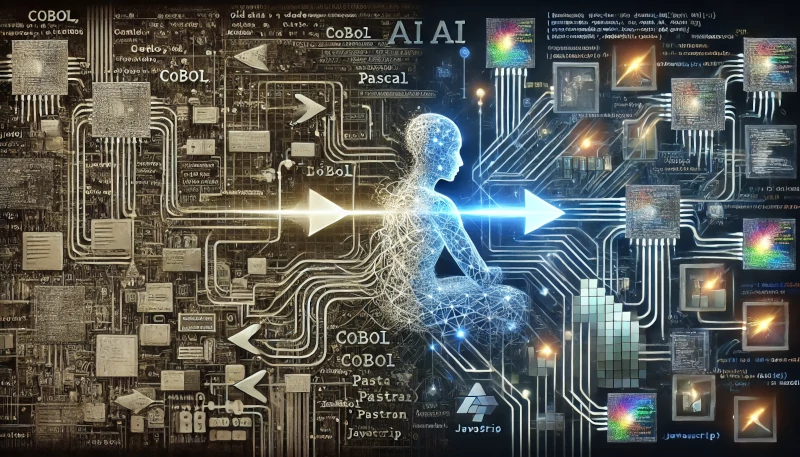Modernizing Legacy Code: How AI and CodeAura Empower Developers for Seamless Code Migration

Legacy code, typically written in outdated programming languages or frameworks, presents a significant challenge for businesses seeking to modernize their software systems. Over time, this code can become inefficient, difficult to maintain, and incompatible with modern software architectures. Migrating legacy systems to new platforms or languages is no small task; it requires a deep understanding of the existing codebase, meticulous documentation, and a structured migration process.
This is where AI steps in. By leveraging artificial intelligence, businesses can greatly enhance their ability to understand, document, and migrate legacy code, saving time and reducing errors. CodeAura, a cutting-edge AI-powered platform, is specifically designed to assist in this process. It plays a pivotal role in simplifying the complexities of legacy code management, offering developers unparalleled insights and automation tools that smoothen the transition to modern programming languages.
Understanding Legacy Code with AI
One of the primary challenges when dealing with legacy code is understanding its structure, purpose, and interdependencies. Over the years, teams often lose knowledge of how specific parts of the system work, and the original developers may no longer be available to provide context. This is where AI’s capabilities for analyzing and deciphering code become crucial.
AI-powered tools like CodeAura can analyze large codebases, identify patterns, detect redundancies, and even flag potential vulnerabilities that may not be obvious to human developers. Through natural language processing (NLP), AI can parse code documentation (or lack thereof), extract meaningful insights, and generate readable explanations for what each segment of the code does. This contextual understanding is essential for teams when they need to dive deep into legacy systems that may be poorly documented or filled with technical debt.
CodeAura uses advanced machine learning algorithms to break down code into understandable blocks, explaining it in simple terms. This AI-assisted code interpretation helps developers understand legacy logic, whether it’s written in an obscure programming language or built with outdated frameworks.
Documenting Legacy Code
Accurate documentation is critical for any code migration project. However, legacy systems often suffer from poor documentation, making it difficult for developers to understand the code’s intent, architecture, and flow. AI can automatically generate or improve documentation for legacy code, filling in gaps that human teams might overlook. By analyzing code structures, dependencies, and execution paths, AI tools can create comprehensive documentation that acts as a blueprint for future developers.
CodeAura stands out by offering automated code documentation features. It leverages its AI engine to identify the key modules, relationships, and workflows within the legacy system and produces detailed documentation. This documentation can include flowcharts, UML diagrams, or even comments embedded directly into the code, enabling developers to understand the system more holistically. With CodeAura, teams don’t have to worry about starting from scratch when it comes to documenting a 10-year-old codebase. The platform not only accelerates this process but also ensures accuracy and completeness.
Migrating to Modern Programming Languages
Migration is the most challenging phase of modernizing a legacy system. It requires transforming the existing codebase into a new language or framework without losing the original system’s functionality. This is where CodeAura proves invaluable by automating much of the migration process.
AI can map older code constructs into newer equivalents, flag deprecated libraries, and even recommend best practices for modern development. CodeAura’s AI-powered migration toolset can automate significant portions of this task. For example, when migrating from an outdated language like COBOL or Fortran to modern languages like Python or JavaScript, CodeAura’s intelligent algorithms convert legacy syntax and structures into their modern counterparts.
Furthermore, AI plays a critical role in refactoring the code to ensure that the new version is more efficient and scalable. Instead of just translating line-by-line, CodeAura’s machine learning models can optimize the code, reducing redundancy and improving performance. It assists developers in rewriting complex legacy logic into modern, maintainable, and reusable code.
In addition, CodeAura integrates robust testing capabilities to validate the migrated code, ensuring it works seamlessly with new systems. The platform generates unit tests and integration tests automatically, further reducing manual effort and catching potential issues early in the process.
Security and Compliance in the Migration Process
Legacy systems often contain hidden security vulnerabilities that can become exposed during the migration process. CodeAura incorporates AI-based security analysis, helping identify and patch vulnerabilities in the legacy code before migrating it to a new platform. This ensures that as the code evolves, it complies with modern security and regulatory standards.
Conclusion
AI-powered tools like CodeAura represent a revolution in how developers handle legacy code. By automating the understanding, documentation, and migration process, CodeAura empowers teams to breathe new life into outdated systems, paving the way for smoother transitions to modern architectures. With its intelligent analysis, automated documentation, and guided migration capabilities, CodeAura is an essential tool for any business looking to modernize legacy codebases efficiently and securely.
In a world where technology is constantly evolving, CodeAura stands at the forefront, bridging the gap between the old and the new, ensuring businesses remain agile and future-proof.

